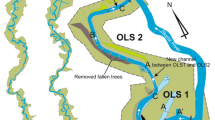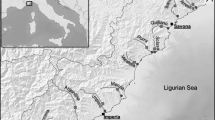Abstract
Floodplains are simultaneously among the most species-rich and the most threatened ecosystems. Alien aquatic macroinvertebrates contribute to this threat but remain scarcely studied in the lateral dimension of floodplains. We modelled the realized ecological niches of the alien species occurring in 24 floodplain channels of the Rhône River. Environmental variables depicting the ecological niches were associated to the lateral hydrological connectivity and light availability, both being modified during floodplain restoration works. Eight alien species were observed and they demonstrated either ubiquity or a restricted niche, with no link to the date of introduction. For most of them, the main river channel appeared as an important dispersal route in the lateral dimension of the floodplain. An increase of both lateral connectivity and light availability favoured most of the modelled species. Consequently, we recommend that sector-scale restoration programmes preserve varying levels of lateral connectivity for floodplain channels to prevent the expansion of alien aquatic macroinvertebrates.





Similar content being viewed by others
References
Bernauer D, Jansen W (2006) Recent invasions of alien macroinvertebrates and loss of native species in the upper Rhin River, Germany. Aquat Invasions 1:55–71
Bij de Vaate A, Jazdzewski K, Ketelaars HAM, Gollasch S, Van der Velde G (2002) Geographical patterns in range extension of Ponto-Caspian macroinvertebrate species in Europe. Can J Fish Aquat Sci 59:1159–1174
Binder E (1965) Un mollusque envahissant, la Dreissena polymorpha. Musées de Genève 54:2–4
Bollache L, Devin S, Wattier R, Chovet M, Beisel JN, Moreteau JC, Rigaud T (2004) Rapid range extension of the Ponto-Caspian amphipod Dikerogammarus villosus in France: potential consequences. Archiv Für Hydrobiologie 160:57–66
Buijse AD, Coops H, Staras M, Jans LH, Van Geest GJ, Grift RE, Ibelings BW, Oosterberg W, Roozen F (2002) Restoration strategies for river floodplains along large lowland rivers in Europe. Freshw Biol 47:889–907
Buisson L, Thuiller W, Lek S, Lim P, Grenouillet G (2008) Climate change hastens the turnover of stream fish assemblages. Glob Chang Biol 14:2232–2248
Colautti RI, MacIsaac HJ (2004) A neutral terminology to define ‘invasive’ species. Divers Distrib 10:135–141
Colling M (1996) Ökologische Typisierung der aquatischen Makrofauna. Informationsberichte des Bayerischen Landesamtes für Wasserwirtschaft, München
Crozet B, Pedroli JC, Vaucher C (1980) 1st findings of Potamopyrgus-jenkinsi Smith (Mollusca, Hydrobiidae) in western Switzerland. Rev Suisse Zool 87:807–811
Daufresne M, Bady P, Fruget JF (2007) Impacts of global changes and extreme hydroclimatic events on macroinvertebrate community structures in the French Rhône River. Oecologia 151:544–559
Davies-Colley RJ, Payne GW (1998) Measuring stream shade. J North Am Benthol Soc 17:250–260
Dedecker AP, Goethals PLM, Gabriels W, De Pauw N (2004) Optimization of Artificial Neural Network (ANN) model design for prediction of macroinvertebrates in the Zwalm river basin (Flanders, Belgium). Ecol Modell 174:161–173
Denicola DM, Hoagland KD, Roemer SC (1992) Influences of canopy cover on spectral irradiance and periphyton assemblages in a prairie stream. J North Am Benthol Soc 11:391–404
Devin S, Bollache L, Noel PY, Beisel JN (2005) Patterns of biological invasions in French freshwater systems by non-indigenous macroinvertebrates. Hydrobiologia 551:137–146
Dillon RT, Wethington AR, Rhett JM, Smith TP (2002) Populations of the European freshwater pulmonate Physa acuta are not reproductively isolated from American Physa heterostropha or Physa integra. Invertebr Biol 121:226–234
Dolédec S, Chessel D, Gimaret-Carpentier C (2000) Niche separation in community analysis: a new method. Ecology 81:2914–2927
Dray S, Dufour AB (2007) The ade4 package: Implementing the duality diagram for ecologists. J Stat Softw 22:1–20
Falkner G, Ripken TEG, Falkner M (2002) Mollusques continentaux de France. Liste de Référence annotée et Bibliographie. Patrimoines naturels, Paris, p 350
Fruget JF (2003) Changements environnementaux, dérives écologiques et perspectives de restauration du Rhône français: bilan de 200 ans d’influences anthropiques. Vertigo 4:1–17
Genovesi P, Shine C (2004) European strategy on invasive alien species. Council of Europe Publishing, Strasbourg, p 50
Germain L (1930) Mollusques terrestres et fluviatiles. In Lechevalier P (ed). Faune de France, Paris, 477 pp
Glöer P, Meier-Brook C, Ostermann O (1992) Süßwassermollusken. Deutscher Jugendbund für Naturbeobachtung (DJN), Hamburg, p 111
Green AJ, Figuerola J (2005) Recent advances in the study of long-distance dispersal of aquatic invertebrates via birds. Divers Distrib 11:149–156
Hall R, Tank JL, Dybdahl MF (2003) Exotic snails dominate nitrogen and carbon cycling in a highly productive stream. Front Ecol Environ 1:407–411
Hastie TJ, Tibshirani RJ (1990) Generalized Additive Models. Chapman & Hall, London, p 335
Humpesch U, Fesl C (2005) Biodiversity of macrozoobenthos in a large river, the Austrian Danube, including quantitative studies in a free-flowing stretch below Vienna: a short review. Freshw Forum 24:3–23
Ihaka R, Gentleman R (1996) R: a language for data analysis and graphics. J Comput Graph Stat 5:299–314
Johnson LE, Padilla DK (1996) Geographic spread of exotic species: Ecological lessons and opportunities from the invasion of the zebra mussel Dreissena polymorpha. Biol Conserv 78:23–33
Khalanski M (1997) Industrial and ecological consequences of the introduction of new species in continental aquatic ecosystems: The zebra mussel and other invasive species. Bulletin français de la pêche et de la pisciculture 344(345):385–404
Kinzelbach R (1995) Neozoans in European waters—exemplifying the worldwide process of invasion and species mixing. Experientia 51:526–538
Lake PS (2000) Disturbance, patchiness, and diversity in streams. J North Am Benthol Soc 19:573–592
Lake PS, Bond N, Reich P (2007) Linking ecological theory with stream restoration. Freshw Biol 52:597–615
Lehmann A, Overton JM, Leathwick JR (2002) GRASP: generalized regression analysis and spatial prediction. Ecol Modell 157:189–207
Locard A (1881) Catalogue des Mollusques vivants terrestres et aquatiques du département de l’Ain. Mém. acad. r. Sci. Belles-Lett. Arts Lyon, Sect. Sci., (2)25 [1881–1882] 1–151 pp
Lockwood JL, Hoopes MF, Marchetti MP (2007) Invasion ecology. Blackwell, Malden, MA, USA, p 304
Meier-Brook C (2002) What makes an aquatic ecosystem susceptible to mollusc invasion. In: Falkner M, Groh K, Speight MCD (eds) Collectanea Malacologica. ConchBooks, Hackenheim, pp 405–417
Mérigoux S, Dolédec S (2004) Hydraulic requirements of stream communities: a case study on invertebrates. Freshw Biol 49:600–613
Mérigoux S, Lamouroux N, Olivier JM, Dolédec S (2009) Invertebrate hydraulic preferences and predicted impacts of changes in discharge in a large river. Freshw Biol 54:1343–1356
Morley NJ (2008) The role of the invasive snail Potamopyrgus antipodarum in the transmission of trematode parasites in Europe and its implications for ecotoxicological studies. Aquat Sci 70:107–114
Mouthon J (2000) Répartition du genre Corbicula Megerle von Mühlfeld (Bivalvia: Corbiculidae) en France à l’aube du XXIe siècle. Hydroécologie appliquée 12:135–146
Mouthon J (2003) Longitudinal and temporal variations of density and size structure of Corbicula fluminea (Bivalvia) populations in the Saône and Rhône Rivers (France). Ann Limnol-Int J Limnol 39:15–25
Mouthon J, Daufresne M (2006) Effects of the 2003 heatwave and climatic warming on mollusc communities of the Saône: a large lowland river and of its two main tributaries (France). Glob Chang Biol 12:441–449
Müller JC, Schramm S, Seitz A (2002) Genetic and morphological differentiation of Dikerogammarus invaders and their invasion history in Central Europe. Freshw Biol 47:2039–2048
Murria C, Bonada N, Prat N (2008) Effects of the invasive species Potamopyrgus antipodarum (Hydrobiidae, Mollusca) on community structure in a small Mediterranean stream. Fundam Appl Limnol 171:131–143
Paillex A, Castella E, Carron G (2007) Aquatic macroinvertebrate response along a gradient of lateral connectivity in river floodplain channels. J North Am Benthol Soc 26:779–796
Paillex A, Dolédec S, Castella E, Mérigoux S (2009) Large river floodplain restoration: predicting species richness and trait responses to the restoration of hydrological connectivity. J Appl Ecol 46:250–258
Palmer MA, Bernhardt ES, Allan JD, Lake PS, Alexander G, Brooks S, Carr J, Clayton S, Dahm CN, Shah JF, Galat DL, Loss SG, Goodwin P, Hart DD, Hassett B, Jenkinson R, Kondolf GM, Lave R, Meyer JL, O’Donnell TK, Pagano L, Sudduth E (2005) Standards for ecologically successful river restoration. J Appl Ecol 42:208–217
Pfenninger M, Reinhardt F, Streit B (2002) Evidence for cryptic hybridization between different evolutionary lineages of the invasive clam genus Corbicula (Veneroida, Bivalvia). J Evol Biol 15:818–829
Pimentel D (2005) Aquatic nuisance species in the New York State Canal and Hudson River systems and the Great Lakes Basin: an economic and environmental assessment. Environ Manage 35:692–701
Puky M, Schad P (2006) Orconectes limosus colonises new areas fast along the Danube in Hungary. Bulletin français de la pêche et de la pisciculture 380(381):919–925
Rahel FJ, Olden JD (2008) Assessing the effects of climate change on aquatic invasive species. Conserv Biol 22:521–533
Renard E, Bachmann V, Cariou ML, Moreteau JC (2000) Morphological and molecular differentiation of invasive freshwater species of the genus Corbicula (Bivalvia, Corbiculidea) suggest the presence of three taxa in French rivers. Mol Ecol 9:2009–2016
Reynoldson TB, Young JO (2000) A key to the freshwater triclads of Britain and Ireland, with notes on their ecology. Freshwater Biological Association, Ambleside, Cumbria, UK, p 72
Rostan JC, Amoros C, Juget J (1987) The organic content of the surficial sediment: a method for the study of ecosystems development in abandoned river channels. Hydrobiologia 148:45–62
Roux AL, Bravard JP, Amoros C, Pautou G (1989) Ecological changes of the French Upper-Rhône River since 1750. In: Petts GE, Möller H, Roux AL (eds) Historical change of large alluvial rivers: Western Europe. Wiley, Chichester, pp 323–350
Russier R, Lacombe C (1970) La planaire américaine Dugesia tigrina dans la région lyonnaise: écologie et tolérance thermique. Bulletin Mensuel de la Société Linnéenne de Lyon 39:197–206
Sousa R, Antunes C, Guilhermino L (2008) Ecology of the invasive Asian clam Corbicula fluminea (Müller, 1774) in aquatic ecosystems: an overview. Ann Limnol, Int J Limnol 44:85–94
Sparks RE (1995) Need for ecosystem management of large rivers and their floodplains. Bioscience 45:168–182
Spooner DE, Vaughn CC (2009) Species richness and temperature influence mussel biomass: a partitioning approach applied to natural communities. Ecology 90:781–790
Stucki P, Zaugg B (2005) Decapoda. Fauna Helvetica 15:56
Tockner K, Stanford JA (2002) Riverine flood plains: present state and future trends. Environ Conserv 29:308–330
Vanschoenwinkel B, Waterkeyn A, Vandecaetsbeek T, Pineau O, Grillas P, Brendonck L (2008) Dispersal of freshwater invertebrates by large terrestrial mammals: a case study with wild boar (Sus scrofa) in Mediterranean wetlands. Freshw Biol 53:2264–2273
Ward JV, Tockner K, Schiemer F (1999) Biodiversity of floodplain river ecosystems: ecotones and connectivity. Regul Rivers Res Manage 15:125–139
Williams CJ, McMahon RF (1986) Power station entrainment of Corbicula fluminea (Müller) in relation to population dynamics, reproductive cycle and biotic and abiotic variables. Am Malacol Bull Spec Ed 2:99–111
Acknowledgments
We are grateful to J. -M. Olivier and N. Lamouroux for the coordination of the restoration programme on the French Rhône River. We thank S. Mérigoux and two anonymous reviewers for their comments on a previous version of the article. We thank also D. McCrae for editing the English and for carrying out the solar access measurements. We are grateful to B. Lachal and E. Pampaloni for initial discussion on light availability and for lending the fish-eye equipment. We also thank all the people who participated in the field campaigns, the sorting and the identification of macroinvertebrates. This research was jointly funded by the « Compagnie Nationale du Rhône », the « Agence de l’Eau Rhône-Méditerranée et Corse », the « Direction Régionale de l’Environnement », the « Région Rhône-Alpes » and the « Centre en Sciences Naturelles de l’Environnement » of the University of Geneva.
Author information
Authors and Affiliations
Corresponding author
Rights and permissions
About this article
Cite this article
Besacier-Monbertrand, AL., Paillex, A. & Castella, E. Alien aquatic macroinvertebrates along the lateral dimension of a large floodplain. Biol Invasions 12, 2219–2231 (2010). https://doi.org/10.1007/s10530-009-9632-z
Received:
Accepted:
Published:
Issue Date:
DOI: https://doi.org/10.1007/s10530-009-9632-z




